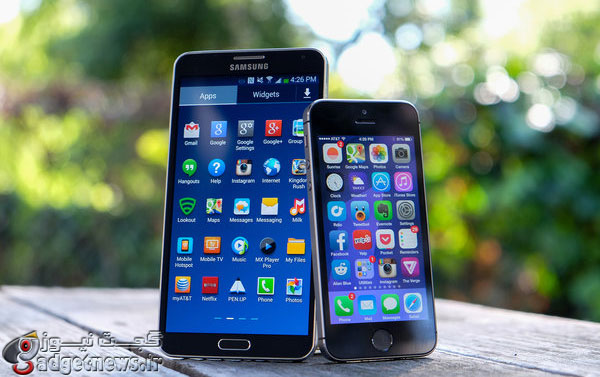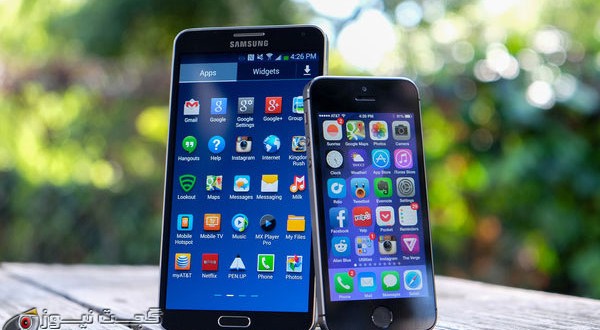
رقابت تنگاتنگ دو شرکت بزرگ اپل و گوگل بر کسی پوشیده نیست. هر دوی این شرکتها عزم خود را جزم کردهاند تا با عرضه پلتفرمهایی یکپارچه، خیل عظیم کاربران مشتاق را به سمت خود بکشانند. یکی به هوشمند بودن نوتیفیکیشن هایش مینازد، یکی از مالتی تسکینک بی نظیرش میگوید. یکی تمرکز را بر روی سرویسها قرار میدهد، یکی اولویت را در سخت افزار میداند. اما هدف نهایی این دو شرکت یک چیز است: خلق اکوسیستمی واحد که تمام نیازهای کاربران را یکجا تامین کند.
هر چند دو شرکت اپل و گوگل، هر یک خود را در جایگاه برتر میبینند، اما واقعیت این است که پلتفرمهای موبایل این دو شرکت، سال به سال و ماه به ماه، به یکدیگر شبیه تر میشوند. اپل تلاش میکند فاصله میان iOS و OS X را به حداقل برساند. گوگل هم در پی یکپارچه کردن اندروید و Chrome OS است. اپل HealthKit را رو میکند؛ گوگل از Google Fit میگوید. هدف هر دو شرکت ایجاد یک اکوسیستم جامع مشتمل بر سخت افزار، سرویسها و اپلیکیشن هاست؛ به طوری که مصرف کنندگان به این اکوسیستم وارد شده، به آن خو بگیرند و هوس خروج از آن به سرشان نزند.
به طور حتم عموم ما ترجیح میدهیم که همه گجت هایمان در یک ساختار واحد به هم متصل باشند. شاید این قضیه هنوز برای بسیاری از ما حائز اهمیت نباشد. اما بدانید که در آینده ای بسیار نزدیک، یک انتخاب ساده مانند خرید یک تلفن هوشمند، بر روی انتخابهای بعدی شما تاثیر خواهد گذاشت. به طور مثال، خرید یک تلفن هوشمند اندرویدی به این معنا خواهد بود که شما میبایست تبلت، تلویزیون، ساعت، یا حتی خودرویی بخرید که در اکوسیستم اندروید کار کند.
گوگل در مراسم I/O 2014 از یکپارچه شدن تجربه کاربری در همه دستگاههایش سخن به میان آورد. گویا تلفن هوشمند اندرویدی به عنوان مرکز فرماندهی عمل خواهد کرد. هر کاری که در اکوسیستم اندروید انجام میدهید، برای یک بار هم که شده گذرش به تلفن هوشمندتان خواهد افتاد و در یک کلام تلفن شما در قالب قلب اکوسیستم اندروید، همه فرامین و درخواستها را مدیریت خواهد کرد.
اپل هم دقیقا همین رویکرد را برگزیده. اپل در نظر دارد کاری کند که شما بتوانید توسط یک دستگاه آیفون کل دنیایتان را کنترل کنید. با این تفاوت که اپل میخواهد خانه های هوشمند را با HomeKit پیاده کند، گوگل به خرید شرکتهای فعال در زمینه خانه های هوشمند یعنی Nest دست میزند. اپل از Apple TV میگوید و گوگل از Android TV. اپل، اکوسیستم خود را به کمک CarPlay وارد دنیای خودروها میکند و گوگل از Android Auto میگوید. همانطور که میبینید رسالت هر دو شرکت یکی است.
شاید تلفنی که میخرید، پس از یکی دو سال یا حداکثر چند سال قدیمی شود و شما به فکر یک جایگزین برای آن بیافتید. اما اکوسیستم چطور؟ وقتی شما، بر فرض مثال، چند سال از سرویسهای گوگل استفاده کنید و به آن خو بگیرید و تبلت، تلویزیون، ساعت هوشمند و سایر گجت های ریز و درشت خود را بر اساس اکوسیستم گوگل خریداری کنید، مهاجرت به اکوسیستم همسایه برایتان دشوار خواهد بود. شاید کمی مصرف گرایانه به نظر برسد (!) اما ظاهرا زمان انتخاب اکوسیستم مطلوب فرا رسیده است. اندروید، اپل، ویندوز، … انتخاب با شماست.
شما از ميان اپل و گوگل کدام اکوسيستم را انتخاب مي کنيد ؟
لطفا در رای گیری زیر شرکت کرده و بگویید شما کدام طرفی هستید ؟
منبع :theverge
iPhone or Android: it's time to choose your religion
It’s impossible for Google or Apple to introduce a new feature, let alone a whole new revision, to their mobile operating systems without it instantly being compared to the other’s alternative. The sparks that inflame heated discussions about who’s got the better notifications or smarter multitasking come right from the top of both companies. While unveiling Android L yesterday, Google’s Sundar Pichai took a subtle dig at Apple’s new iOS 8 by saying that custom keyboards and widgets "happened in Android four to five years ago." Three weeks earlier, Apple CEO Tim Cook was more direct in his critique:
Many of [our new] customers were switchers from Android. They had bought an Android phone — by mistake — and then had sought a better experience. And a better life.
Though both companies have embraced their adversarial relationship, their mobile platforms are actually growing more similar than different in their function and purpose. Apple has Continuity between iOS and OS X, while Google has synced notifications between Android and Chrome OS. One company’s HealthKit is the other’s Google Fit. The goal is the same for both: to build a comprehensive ecosystem of hardware, services, and apps that locks users in.
"The goal is to create an ecosystem that no one would ever want to leave"
Life will surely be sweeter once every gadget you own relates intelligently to every other, but to get there, you’ll have to decide where your loyalties lie. And the fact that both Android and iOS platforms are set for their biggest updates in years this fall means that the obsessive comparisons between them will be as salient as they’ve ever been. More than ever, your smartphone preference will dictate your choice of tablet, TV, car, watch, and even fitness tracker.
Google’s marathon I/O 2014 keynote demonstrated a grand plan to deliver a cohesive and unified experience across all manner of devices and screen sizes. Unmistakable, however, was the hub-like function of the Android smartphone. The new Android Wear for smartwatches (and eventually other wearables as well) does a number of neat things, but most of them rely on a connection to an Android phone. If you want to order pizza by mashing on your wrist, you’ll need to get into Google’s ecosystem. The same is true if you want to make use of the new Android TV functionality that will come installed on Sony and Sharp TVs this year — another reason to buy an Android device. As expansive as Google appears to be, it all eventually links back to the phone, which is the personal heart of the ecosystem that the company is building.
Apple’s approach is no less ambitious. Its new software will sync not just your photos, but even your edits to those photos across devices. Apple wants the iPhone to control your entire house with HomeKit and to be your personal physician with HealthKit. Apple TV and AirPlay already offer much of the interactivity that Android TV promises, while CarPlay is set to expand the iPhone’s influence in a similar fashion to how Google envisions Android Auto will make its phones more useful for drivers. All these overlapping approaches are just spokes that keep returning to the crucial hub that is the smartphone: iPhone for one camp or Android for the other.
"The phone remains at the center"
Amazon recognized this dynamic — the necessity for a phone to serve as the anchor point of a broad web-based ecosystem — with the recent introduction of its own Fire Phone. Microsoft knows it just as well, and has been trying for years to make Windows Phone a credible alternative to the established leaders. The choice of a person’s first smartphone drives so many of the subsequent decisions that he or she will make — such as which music streaming, cloud storage, or photo-sharing service to use — that it becomes paramount for companies to make sure that initial device is running their software. Google’s low-cost Android One hardware platform aims to achieve precisely that goal with smartphone newcomers in developing markets.
What Apple and Google are building is what Nike, Adidas, and all the fashion brands wish they had: a set of concrete reasons to compel people to use one company for all their needs. It’s brand loyalty based on practicality as much as emotional attachment.
This is broadly to the benefit of the user. iOS 8 looks hugely promising in part because of the ways it’s caught up to Android with basics like widgets, interactive lock-screen notifications, and general platform openness to third-party modifications. Android is also growing more polished and refined with each new iteration, closing the gap in aesthetics and responsiveness. The basic feature sets of the two operating systems are nearly identical, and now it’s the branching out from that core functionality that’s setting them apart and forcing people to choose one or the other. It will be hard to switch between them, but iOS and Android are doing their utmost to make that unnecessary.
"Neither Google nor Apple seems interested in connecting their respective walled gardens"
The utopian scenario would be to have one global ecosystem where the communication between Apple and Google was about device interoperability instead of trash talk among execs. In its absence, a few sprouts of hope come from companies like Nike and the Google-owned (but still independently operated) Nest. The latter just opened up software development for making apps for its Learning Thermostat while the former will make its Fuel points available for users of both Google Fit and Apple’s HealthKit to use in quantifying their fitness.
Until this year, the major updates to iOS and Android have always come at different times and focused on different things, making direct side-by-side comparisons dicey and unreliable. But now the two dominant mobile platforms look to be doing the same thing at the same time: expanding their reach into cars, health, the home, and wearables, while also unifying the user experience across all their devices. Google and Apple’s plans are coalescing around similar priorities and both promise their next big software release in the fall. That will be when the clash between their offerings will be felt most starkly, and when the choice between the two will be more impactful than ever.
The old specter of Apple’s walled garden remains. And the more unified Google becomes, the more it’s beginning to resemble it. The difference with the latest software from both, however, is in the scale of the closed ecosystems that are being built. They are, by design, big enough to fit your whole life into. While the next phone you buy might not last much longer than a couple of years, the ecosystem it plugs and locks you into will likely be the one you use for a long time to come.
 گجت نیوز آخرین اخبار تکنولوژی، علم و خودرو
گجت نیوز آخرین اخبار تکنولوژی، علم و خودرو 






